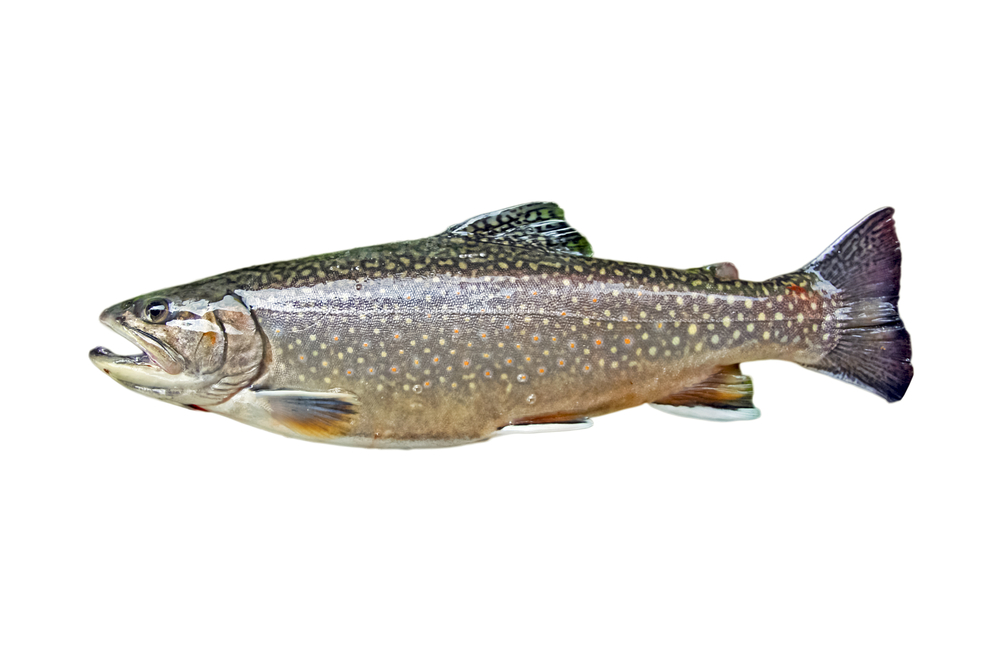Markings and Coloration
Brown trout are the true trout. They are native to Europe, western Asia, and the extreme northeastern edge of Africa and have been introduced to many waters suited to them around the globe. Fishing for sport–including fly-fishing–evolved within the native range of brown trout. The word “trout” itself apparently evolved with specific reference to these fish and was later applied to such fish as rainbow, cutthroat, and brook trout simply because of their resemblance to brown trout.
Although all brown trout are categorized as a single species, the fish themselves may show wide variation in color and spotting patterns, habitual foods, and behavior. Any angler who fishes a variety of rivers may eventually encounter brown trout that somehow look different from those he’s used to catching and may even encounter two different-looking brown trout in the same stream. Color along the dorsal surface (back) varies from olive-brown through yellowish brown, becoming lighter toward the whitish belly area. There are usually greater amounts of an overall yellow tint along the flanks. Black spots are present on the back and in diminishing numbers down the sides. Bright red spots are found in lesser numbers along the sides. There are few, if any, spots on the tail in contrast with rainbow, the tails of which are heavily spotted. Unlike brook trout, brown trout have no vermiculations, or wavy lines on their backs and have teeth along the full length of the vomerine bone on the roof of their mouths. Brown-trout coloration is much subdued in hatchery fish, but often assume the brighter colors of wild fish after several months in the stream.
Brown trout are also unique in that they are able to change their color quite rapidly as a means of concealment. Brown trout are also the only fish ever to rest on the stream bottom. This also explains their success in many waters: They are just plain hard to spot both by predators and fishermen. NOTE: The color changes mentioned refer to changes in the background color of the trout’s skin–they can’t change their spots.
Brown Trout Range and Habitat
The brown trout has a much wider range than the brook trout, and it’s been suggested they can survive in streams that will no longer support brook trout. However, brown trout don’t survive well in warm, polluted water either. They can survive for a short period in 81 degree Fahrenheit water, but usually the upper lethal limit for brown trout is about 77 degrees. Brown trout prefer water ranging from 54 to 67 degrees.
The main reason for the success of brown trout in streams depleted of brook trout is probably because brown trout are harder to catch.
Brown trout are competitive with brook trout in the same stream to the extent that the dominant brown trout were excluding brook trout from favorable resting (not feeding) positions in the stream, thereby making the brook trout more vulnerable to predators. This competition for space in combination with the brook trout’s greater vulnerability to angling clearly puts brook trout at a disadvantage when coexisting with brown trout. This creates a situation that’s often aggravated by many general angling regulations that allow the capture of a certain number of trout per day without regard to species, thus encouraging the removal of brook trout at a faster rate than brown trout.
Brown trout have also been accused of cannibalism—feeding heavily on young trout—this diet leading to a larger-sized fish as well. Again, these characteristics have contributed to a decimated brook trout population and the Park authorities efforts to protect the brook trout.
Two aspects of brown-trout behavior that are of importance to anglers. These two aspects can be divided based on the size of the fish. Smaller brown trout (up to about 12 inches) are called “drift feeders.” They feed primarily on insects and other food items drifting in the current. They typically hold a stationary feeding position and move only to intercept food items in adjacent and faster currents to the side or overhead. Larger brown trout (which grow beyond 12 inches) start to feed on larger items such as crayfish, baitfish, and smaller trout. Because of the difference in diet, they almost always grow much larger than the drift feeders—these are the rare trophy-size browns. Understanding the differences in behavior between these two types of feeders can be vital to the angler.
Specifically, a study in the 1980s showed that a rising trout in flowing water usually keeps rising in the same spot and, assuming the continued availability of suitable surface food, an undisturbed trout will usually rise in the same spot on the next day, and the next, and so on unless the stream configuration changes. Trout fishermen can learn these locations also, just by paying attention when they’re fishing and remembering precisely the locations of rising fish. Gaining this knowledge is one of many ways in which experienced anglers “learn” trout streams, and obviously has a lot to do with fishing success.
The study also showed they didn’t spend most of their time hiding under rocks or near the bank and did not feed only at dawn and dusk; they fed all day as long as they were undisturbed (the shadow of a passing bird, for example). Historically, the average angler hasn’t been able to observe this behavior, and doesn’t know that after a few minutes to a half hour, the fish may return to feeding once again.
Another example is any trout stream that gets heavy recreational use from trout fisherman and others such as canoeists and inner-tube floaters, on summer days–the conditions often found in the Great Smoky Mountain streams during the summer months. The trout are probably hiding under the bank-side or boulders. The trout will again move out into the flats to feed in the late evening, well after the river use has ceased or decreased—to be taken advantage of those fly fishermen who know how to move in the water with the least disturbance. For the areas in the Smokies streams which receive a lot of floaters and swimmers, the message is clear: either fish early or fish late (the brown trout is often nocturnal simply to avoid its predators–they also hunt in the daytime).
Brown Trout Size
As with other kinds of trout, the growth of brown trout is extremely variable, depending primarily on the productivity of a particular stream and also on the strain of brown trout. One-year-old fish may average 3 inches long, and reach an average 6 inches in their second year, 8 inches in their third year, and 12 inches in their fourth year. A seven year life span is typical, unless their predators or anglers get to them first.
The restoration efforts of Park resource managers have led them to closing some streams and tributaries to all fishing, and ensuring natural barriers such as waterfalls are adequate to prevent the brown and rainbow trout from migrating upstream.

